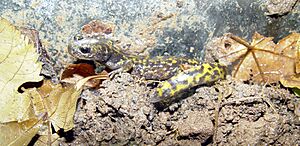Persian brook salamander facts for kids
Quick facts for kids Persian brook salamander |
|
|---|---|
 |
|
| Conservation status | |
| Scientific classification | |
| Genus: |
Paradactylodon
|
| Species: |
persicus
|
| Synonyms | |
|
|
The Persian brook salamander is a special type of salamander. It's also called the Persian mountain salamander. Its scientific name is Paradactylodon persicus. This amazing amphibian lives only in Iran. It might also live in Azerbaijan. It belongs to the Hynobiidae family.
Contents
What Do They Look Like?
Adult Persian brook salamanders have four fingers and toes. They are dark with yellow spots. Their heads are rectangular, and their tails are rounded. Often, their tails are longer than their bodies.
Young salamanders, called larvae, look different. They have large, rounded, triangular heads. Their tails are short and fin-like, usually shorter than their bodies. Larvae are light yellow and don't have spots.
As they grow into juveniles, their skin gets darker. They start to get mottled yellow spots. Their heads become more rectangular. Their tails also grow longer and more rounded.
Larvae and juveniles are about the same size. They range from 4 to 10 centimeters long. Adults are much larger, usually 15 to 20 centimeters long. The longest one ever found was almost 27 centimeters!
Larvae live only in water. They have external gills to breathe underwater. As they grow into adults, they lose their gills. Instead, they develop lungs to breathe air.
Where Do They Live?
The only known groups of these salamanders live in Iran. They are found in the temperate rainforest area. This area is along the southwestern tip of the Caspian Sea.
Scientists think they might also live in parts of Azerbaijan. This is because the same type of rainforest stretches north into that country. However, no one has officially seen them there yet.
These salamanders live in a small area, about 2,000 square kilometers. They mostly stay in rivers, underground karst systems, and caves. This is because they need to live in water.
Behavior and Diet
Adult salamanders that live in caves and karsts are active all year. Other adults hide in their burrows during the day. They are thought to be more active at night.
These salamanders usually breed in fast-moving water. They do not prefer still water. The young larvae often stay in rocky parts of these streams. This gives them lots of places to hide from predators.
Persian brook salamanders are carnivores at every stage of their lives. This means they eat meat. They are known to feed on arthropods and other small creatures. These are animals that share their watery homes.
Scientists once found bat remains inside a salamander's stomach. This is very rare! It's one of the only times a salamander has been known to eat a small flying mammal. These salamanders can also be cannibalistic. This means adults and juveniles have sometimes eaten larvae of their own kind.
Threats to Their Survival
The Persian brook salamander lives in the protected Hyrcanian forest region. In 2008, it was listed as "near threatened." This means it's close to being considered vulnerable. The main reason for this is habitat loss.
Habitat loss happens because of several things:
- City Growth: More towns and cities are being built near the coast and hills of the Caspian Sea.
- Farming: Agriculture, especially rice farms, takes up land where they live.
- Logging: Cutting down trees can cause dirt and mud to wash into streams. This is called siltation. It harms the larvae that rely on clean streams.
- Water Pollution: Pollution in surface water and groundwater is a big problem. Since these salamanders need water to live, pollution affects them a lot.
Scientists also think that dry periods, called droughts, could threaten them. People collecting them for the pet trade might also be a problem. Because threats are increasing and the climate is changing, this species is getting closer to being vulnerable.
Not much is known about this shy and rare salamander. More studies in their natural homes are needed. This will help us understand how many there are and where they truly live. We also need to learn what larvae and adults need to survive. This information will help us protect them.
Images for kids



